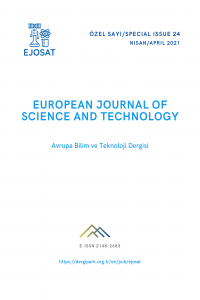Yaygın Kullanılan Çevik Yöntemlerin Küçük Ölçekli Bir Uygulamanın Geliştirilmesi Sürecinde Değerlendirilmesi Üzerine Bir Çalışma
Öz
Yazılım yaşam döngüsünde dış etkenlerden gelecek değişikliklerin kaçınılmaz olduğunu kabul ederek bu değişikliklere daha hzılı ve daha kolay cevap verilebilmesini hedefleyen çevik yazılım geliştirme modelinin ticari sektördeki kullanımı giderek artmaktadır. Çevik geliştirme yaklaşımının tanıtılmasından sonra bu modeli temel alarak farklı bakış açıları ile çözümler sunan pek çok çevik yöntem önerilmiştir. Yöntemlerin belirli bir proje için uygunluğu projenin tipi, büyüklüğü, geliştirme ekibinin büyüklüğü ve deneyimi, organizasyonel etkenler gibi parametreler değerlendirilerek belirlenmelidir. Çevik yöntemlerin sayısının artması ile, projeler için bu yöntemlerin uygunluğunun belirlenerek uygun yöntemin seçimi önemli bir konu haline gelmiştir. Bu çalışmada çevik yöntemler arasında en yaygın olarak kullanılmakta olan Aşırı Programlama (Extreme Programming), SCRUM, Rasyonel Birleştirilmiş Süreç (Rational Unified Process – RUP) ve Kanban yöntemlerinin küçük ölçekli projelerde kullanımının değerlendirilmesi hedeflenmiştir. Bu hedef doğrultusunda bu dört yöntem bir yükseklisans dersi bünyesinde proje olarak geliştirilen küçük çaplı bir uygulamanın geliştirilmesinde farklı ekipler tarafından deneyimlenerek belirli parametrelere göre karşılaştırılmıştır.
Anahtar Kelimeler
Yazılım mühendisliği Yazılım geliştirme yöntemleri Evrimsel geliştirim Çevik süreçler
Kaynakça
- Highsmith, J., & Cockburn, A. (2001). Agile software development: The business of innovation. Computer, 34(9), 120-127.
- Gerald M. Weinberg, as quoted in Larman, Craig; Basili, Victor R. (June 2003). "Iterative and Incremental Development: A Brief History". Computer 36 (6): 47–56. doi:10.1109/MC.2003. 1204375.
- Edmonds, E. A. (1974). "A Process for the Development of Software for Nontechnical Users as an Adaptive System". General Systems 19: 215–18.
- Beck, K.; et al. (2001). “Manifesto for agile software development”, Agile Alliance
- Hunt, J. (2006). Agile methods and the agile manifesto. Agile Software Construction, 9-30.
- Beck, K. (2000). Extreme programming explained: embrace change. addison-wesley professional.
- Jeffries, R., Anderson, A., & Hendrickson, C. (2001). Extreme programming installed. Addison-Wesley Professional.
- Sutherland, J., & Schwaber, K. (2013). The scrum guide. The definitive guide to scrum: The rules of the game. Scrum. org, 268.
- Kruchten, P. (2004). The rational unified process: an introduction. Addison-Wesley Professional.
- Ahmad, M. O., Markkula, J., & Oivo, M. (2013, September). Kanban in software development: A systematic literature review. In 2013 39th Euromicro conference on software engineering and advanced applications (pp. 9-16). IEEE.
- Moniruzzaman, A. B. M., & Hossain, D. S. A. (2013). Comparative Study on Agile software development methodologies. arXiv preprint arXiv:1307.3356.
- Beck, K. (2003). Test-driven development: by example. Addison-Wesley Professional.
- Astels, D. (2003). Test driven development: A practical guide. Prentice Hall Professional Technical Reference.
- Beck, K. (1999). Embracing change with extreme programming. Computer, 32(10), 70-77.
- Rosenberg, D., & Scott, K. (1999). Use case driven object modeling with UML (pp. 1-4). Reading: Addison-Wesley Professional.
A Study on the Evaluation of Commonly Used Agile Methodologies in the Development Process of a Small-Scale Application
Öz
The use of the agile software development model which aims to respond faster and easier to these changes, accepting that changes in the software life cycle are inevitable due to external factors, is gradually increasing in the sector. After the introduction of the agile development approach, many agile methods that offer solutions with different perspectives based on this model have been proposed. The suitability of the methods for a specific project should be determined by evaluating parameters such as the project's type, size, size and experience of the development team, and organizational factors. With the increasing number of agile methods, determining the suitability of these methods for projects and choosing the appropriate method has become an important issue. In this study, it is aimed to evaluate the use of the most common four agile methods in small-scale projects. These methods are Extreme Programming, Scrum, Rational Unified Process (RUP) and Kanban. In line with this goal, these four methods were experienced by different teams in the development of a small-scale application developed as a project within a graduate course and compared according to certain parameters.
Anahtar Kelimeler
Software engineering Software development methodologies Evolutionary development Agile processes
Kaynakça
- Highsmith, J., & Cockburn, A. (2001). Agile software development: The business of innovation. Computer, 34(9), 120-127.
- Gerald M. Weinberg, as quoted in Larman, Craig; Basili, Victor R. (June 2003). "Iterative and Incremental Development: A Brief History". Computer 36 (6): 47–56. doi:10.1109/MC.2003. 1204375.
- Edmonds, E. A. (1974). "A Process for the Development of Software for Nontechnical Users as an Adaptive System". General Systems 19: 215–18.
- Beck, K.; et al. (2001). “Manifesto for agile software development”, Agile Alliance
- Hunt, J. (2006). Agile methods and the agile manifesto. Agile Software Construction, 9-30.
- Beck, K. (2000). Extreme programming explained: embrace change. addison-wesley professional.
- Jeffries, R., Anderson, A., & Hendrickson, C. (2001). Extreme programming installed. Addison-Wesley Professional.
- Sutherland, J., & Schwaber, K. (2013). The scrum guide. The definitive guide to scrum: The rules of the game. Scrum. org, 268.
- Kruchten, P. (2004). The rational unified process: an introduction. Addison-Wesley Professional.
- Ahmad, M. O., Markkula, J., & Oivo, M. (2013, September). Kanban in software development: A systematic literature review. In 2013 39th Euromicro conference on software engineering and advanced applications (pp. 9-16). IEEE.
- Moniruzzaman, A. B. M., & Hossain, D. S. A. (2013). Comparative Study on Agile software development methodologies. arXiv preprint arXiv:1307.3356.
- Beck, K. (2003). Test-driven development: by example. Addison-Wesley Professional.
- Astels, D. (2003). Test driven development: A practical guide. Prentice Hall Professional Technical Reference.
- Beck, K. (1999). Embracing change with extreme programming. Computer, 32(10), 70-77.
- Rosenberg, D., & Scott, K. (1999). Use case driven object modeling with UML (pp. 1-4). Reading: Addison-Wesley Professional.
Ayrıntılar
| Birincil Dil | Türkçe |
|---|---|
| Konular | Mühendislik |
| Bölüm | Makaleler |
| Yazarlar | |
| Yayımlanma Tarihi | 15 Nisan 2021 |
| Yayımlandığı Sayı | Yıl 2021 Sayı: 24 |

